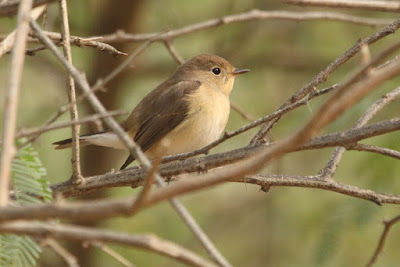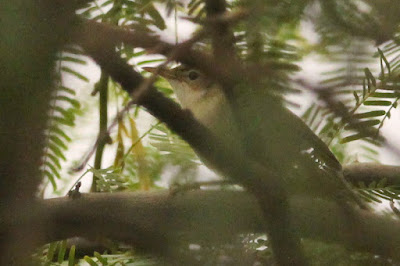With only three records of Calandra Lark in Kuwait, Mashuq Ahmad, Mike Pope and I went and found up to 3 birds at Pivot Fields, south of highway 70, in a flock of skylark
Three days ago, 22nd, myself and Mashuq arrived in Kuwait for ten days. Just before we arrived there had been havoc with flooding, including Kuwait airport, from unusually heavy rain and it was set to continue in the first few days of our stay. However, this wasn't the case with only a few showers but it didn't stop us from getting out. Today, we joined an expat from South Africa, Mike Pope, who took us to an oasis in the middle of the desert called Al Abraq, 120 km WNW of Kuwait City, at 05.45 where we were hoping to find vagrants who take advantage of this green spot. Here we teamed up with another birder, this time from Swansea, Neil Tovey, who had already found a Red-breasted Flycatcher and 6 Penduline Tit. Walking around the farm in the acacia trees, Chiffchaff were feeding and it wasn't long until we picked up onto an acro warbler. It was hard work as we followed it through the trees and didn't really get much on it. Looking at record shots later it thought to be most likely a Caspian Reed Warbler. 2 Blackcap and Garden Warbler also moved through and when we returned to the car to take our jackets off as it started getting hotter, we heard and then saw the 2 Hume's Warbler that have been in the area for the last two weeks and were only the 10th and 11th Kuwaiti records.
This Red-breasted Flycatcher is a scarce passage migrant in Kuwait
This acro warbler very mobile and was thought to be a Caspian Reed Warbler
The best I could do on one of the 2 Hume's Warblers
This is what was waiting for us at our 4x4 when we returned
It was mid-day and we decided to drive around the farm and got good views of a Asian Desert Warbler but when I briefly saw a female Stonechat and I wanted to check it out for Caspian Stonechat. Mike had drove ahead of us and was out of sight while Mashuq and I were getting crippling views of the stonechat using the car as a hide. It became apparent that it was a Siberian Stonechat, most likely of the nominate form maurus
This Asian Desert Warbler was a new species for me
Note the all dark inner webs to the tail-base indicating nominate maurus Also the peachy unstreaked rump.
Siberian Stonechat, most likely the normate forn, maurus
A very rare bird in Kuwait was this Calandra Lark at the Pivot Fields, south of highway 70, and we had a total of 3 Calandra Lark!!























































